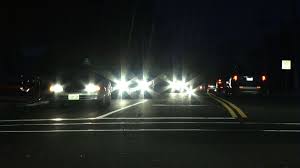Defensive Driving Tip #34: Deal With Light Glare
Many of us have seen the old WWII submarine movies (like “Das Boot”) where the officers don dark goggles and the sub’s interior lights are dimmed to red, in order to protect the night vision of the officers and “lookouts.” This was a matter of life and death — a few seconds on the ocean’s surface without sharp eyes could be disastrous if there were enemy aircraft or surface ships around. When you are a good defensive driving student piloting a vehicle weighing a few thousand pounds down a highway at 90 or 100 feet per second, having sharp night vision is equally as important for you.
Headlights these days are brighter than ever, especially the blue ones. Many vehicles are equipped with halogen lights, or even the newer “blue” high intensity discharge lights, and these take an even greater toll on your eyes’ ability to recover from nighttime light glare. As we get older, our ability to recover our night-vision after exposure to bright lights is one of the first of our visual functions to diminish (a phenomenon called nyctalopia). as a defensive driving instructor I can tell you from my own experience as a professional driver that light glare is one of the most fatiguing things I ever encountered on the highway — a few hours on a highway at night in heavy traffic would often result in not only fatigue, but headaches as well.
First of all, if you are particularly susceptible to light glare recovery problems (if you are, you probably already know it), make sure you slow down at night as you are particularly vulnerable to out-driving your headlights. If you are practicing your defensive driving and you are faced with a driver whose lights are too bright, it is not a good practice to flash your brights at them — although that is common practice and most people do it. Think about the results of this action; instead of having one visually handicapped driver, now we have two, and in a potential head-on situation!
It is also illegal to turn your bright lights on in the face of another driver, or approaching closely behind them, even for just a moment, and I have known highway patrolmen who cite drivers who do this to them. In my state of Arizona, the defensive driving rules are that you must dim your brights within 500 feet of an approaching vehicle, and within 300 feet from behind. Your state has similar provisions.
Deal with light glare by averting your eyes slightly down and to the right. The right-side white stripe outlining the right edge of the usable roadway is called the “fog-line.” One of its purposes is to provide drivers with a reference line to keep their vehicle aligned with the roadway in poor visibility situations — and this is one such situation. Use it to keep your vehicle on the road, but keep aware of the approaching vehicle using your peripheral vision. If that vehicle starts to drift into your lane, you must be able to react quickly (see Avoid Head-on Collisions). If you do get a ticket take our defensive driving class www.2passdd.com
